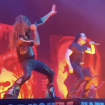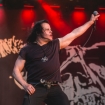Moody, muscular and malevolent, the first Danzig album sounded like nothing else on the charts when it was released on August 30th, 1988. It didn't sound like anything in the metal world, either: At a time of peak hairspray and maximum shred, the debut release from Glenn Danzig's latest musical incarnation was all about sweaty blues and controlled menace, delivered with a demonic thrust that made all the pretty boys with electric toys sound even flimsier and more fatuous than they already were. Although it sounds like classic hard rock today, Danzig seemed almost unclassifiable at the time.
"When the first album came out, we were called a metal band, a thrash band, a speed-metal band, a death-metal band," Danzig recalled to Rolling Stone in 1994. "Nobody knew what we were."
In fact, some longtime fans of Danzig's work had difficulty wrapping their heads (and ears) around Danzig when it first hit the streets. Produced by Rick Rubin, whose Def American imprint also released it, the album — which peaked at #125 on the Billboard 200 in the fall of '88 — was slower, harder, heavier, cleaner and more spacious than anything Danzig had recorded with the Misfits or Samhain, with the music deliberately arranged to let his powerful pipes dominate the proceedings.
Songs like "Twist of Cain," "Am I Demon," "She Rides" and "The Hunter" were closer in sound and spirit to the heavy early Seventies rock that Danzig and Rubin had grown up with, while "Mother" was commercial-sounding enough to (eventually) become the biggest hit of the Evil Elvis' career.
"The whole idea for us, especially with me and Rick, was to create a record that, twenty years down the line, would still be played," Danzig told Concrete Foundations in 1988, shortly after the album's release. "Like, a real classic album that stood the test of time. And we did it, or I hope we did it."
Thirty years later, it's safe to say that Danzig and Rubin accomplished their mission. Not only is the Danzig LP still Danzig's most popular record, but — unlike so many metal and hard rock records of the late Eighties — it still sounds fantastic. So in honor of the 30th anniversary of its unholy birth, here are 10 things you probably didn't know about Danzig, and the events that led to its creation.
1. Danzig was originally supposed to be Samhain's fourth release
Formed in the wake of the Misfits' messy demise, Glenn Danzig's gothic/pagan-influenced outfit Samhain established a devoted cult following of their own with their first three records — 1984's Initium, 1985's Unholy Passion EP and 1986's Samhain III: November-Coming-Fire, all of which had been released on Danzig's independent Plan 9 label. They were already thinking about embarking on their fourth record in July 1986, when Rick Rubin caught their performance at The Ritz in New York City. "Samhain was playing at the New Music Seminar and were scouting labels," Danzig recalled to Concrete Foundations. "We wanted to go to a major label after our third record, and Rick Rubin was there. Basically, he came in after our set and said, 'I want to sign you, you guys are great!'"
While considering offers from Elektra and Epic, as well as Rubin's Def Jam imprint, the band began work on the provisionally titled Samhain IV, which was originally slated to include several songs that would eventually appear on Danzig. "Half those tracks [on Danzig] were songs I was writing for Samhain," Danzig told City Pages in 2013. Two future Danzig songs, "Twist of Cain" and "Possession," were initially demoed in September 1986 at Reel Platinum studios in Lodi, New Jersey, with Danzig on vocals and guitar and the Samhain rhythm section of Eerie Von and London May on bass and drums, respectively; Samhain guitarist Damien had already been sacked from the band.
"We weren't happy with our guitar player and I was doing most of the guitar tracks in the studio, which was stupid 'cause he was the guitar player and he should've been doing it," Danzig explained to Concrete Foundations. "Rick said, 'You guys need a new guitar player,' and I was like, 'Tell me about it!'"
2. Danzig had no idea who Rick Rubin was before the Def Jam owner approached him about signing to his label
Though Rick Rubin had already established himself as a rising industry talent by the summer of 1986, thanks to his production work with rappers LL Cool J and Run-DMC, and his founding of the influential Def Jam imprint with hip-hop promoter Russell Simmons, Danzig had never heard of him before their paths crossed at The Ritz.
"Rubin had signed Slayer at the New Music Seminar [in 1985]," Danzig told Seconds in 1997. "He came down next year [to see us] and came backstage and I didn't know who he was. I knew the Beastie Boys, but I didn't know he was working with them. Here's this guy with a long ZZ Top beard going crazy backstage and I'm like, 'Who the fuck is this guy?' He's telling me people he knows and I said, 'I know [punk-rock photographer] Glen Friedman,' and he said, 'Call him, he'll tell you who I am.'"
Soon afterwards, Danzig met with Rubin at Def Jam's offices. "He played me some stuff," Danzig recalled in a 1989 interview with Hollywood Book and Poster. "[Def Jam] was a street-level operation then. It was great. He likes bands for the reasons that I like bands: Music that's aggressive and violent."
3. Rick Rubin was not a Misfits fan — or even a Samhain fan, for that matter
Though Rubin raved backstage at The Ritz about wanting to sign Samhain, the truth was that he really only wanted to sign Glenn Danzig, and build a new group around him. "I was never a Misfits fan," Rubin told Kerrang! in 1988. "I didn't like them and I actually thought they were terrible. But I always knew that Glenn was a great singer and that he had great songwriting potential that hadn't been fully realized."
As Danzig and Rubin continued to discuss the possibility of working together, the producer/label owner finally came clean about the fact that he wasn't really into Samhain, either. "He said, 'To be honest, I don't want any of these old guys,'" Danzig later recalled to Seconds. "[He said,] 'Eerie can't play, the drummer can't play. All I want to do is sign you.'" Danzig insisted that Eerie Von remain on bass, but agreed that it was time to find a new drummer and guitarist. He and Rubin also decided that this new outfit should bear his name. "I was like, 'I'm tired of changing names of bands. We should just call it Danzig. I'll never have to change the name again.'"
4. "Philthy Animal" Taylor of Motörhead was one of Danzig's original choices for a drummer
After signing with Def Jam (which would be renamed Def American in time for Danzig's release), Danzig and Rubin spent six months searching for the right lead guitarist; they finally found one in John Christ, a previously unknown musician from Baltimore. "He came in and we had 10 minutes left [of studio time]," Danzig recalled to Hollywood Book and Poster. "He was waiting all night, so we said, 'You got 10 minutes.' He came on like blazes. He beat out all the competition, so he got it. Rick really liked him, [and] I liked his leads better than anyone else's."
Once Christ officially joined the band in February 1987, only the drum stool remained open. Danzig had two top choices: Chuck Biscuits, who had previously played with D.O.A., Black Flag, Circle Jerks and the Red Hot Chili Peppers, and former Motörhead drummer "Philthy Animal" Taylor. "When we decided to dump our other drummer, Rick asked me who were my two favorite drummers," Danzig told Hollywood Book and Poster. "I said Philthy Phil and Chuck Biscuits. Philthy, we decided, might be kind of old and set in his ways. He might not listen if you said, 'Play that this way.' I'm real picky and so is Rick. And Chuck Biscuits was available."
Biscuits proved to be a good fit for the band; and while no one from the Danzig camp ever officially reached out to Taylor, it was later revealed that he was already in the process of re-joining Motörhead after a three-year hiatus, and thus wouldn't have been available anyway.
5. James Hetfield sings backing vocals on the album
In the summer of 1987, while Samhain was still looking for a major label deal, Metallica gave Danzig's industry stock a major boost by including a medley of his Misfits songs "Last Caress" and "Green Hell" on The $5.98 E.P.: Garage Days Re-Revisited. Though Danzig generally played coy in interviews about whether or not the recording had any real effect on his career, he genuinely appreciated Metallica's support. So when James Hetfield offered to lend his vocal services to the recording of Danzig, Danzig was more than happy to take him up on it.
"He was hanging out with us in L.A.," Danzig told City Pages. "I had to go back to the studio. He said he wanted to come along. I was like, 'Oh, sure! Don't worry about it.'" Though Hetfield was not credited on the album due to contractual issues — Metallica's label Elektra might have frowned upon any freelancing — his unmistakable growl can be heard on the choruses of at least two of the album's tracks. "He's on 'Possession,' 'Twist of Cain' and probably one other one," Danzig revealed to City Pages. "He's not on 'Mother.' But he's on probably one other track."
6. Danzig took full songwriting credit for "The Hunter" — but he didn't actually write it
With its swaggering groove, brawny blues riffs, ominous lyrics and Danzig's demonic roar, the Danzig track "The Hunter" showcased all that was great about Danzig the band. Only one problem: While the album's credits read "All songs written by Glenn Danzig," "The Hunter" had actually been written in 1967 by members of Memphis soul group Booker T. and the MGs with help from songwriter Carl Wells.
It had also been recorded numerous times before Danzig got to it, first by bluesman Albert King, and later by hard rockers Blue Cheer, Free and Led Zeppelin, the latter of whom interpolated it into their song "How Many More Times." Perhaps taking a plagiaristic page out of Led Zep's book, Danzig rewrote some of the lyrics — unlike the song's original protagonist, Danzig's hunter eschews the use of a "love gun" in favor of ripping his prey to pieces — while helping himself to all of the songwriting credit.
7. "Mother" was originally a straightforward punk-rock song
Released as Danzig's lead single in August 1988, "Mother" would need another five years and a fresh remix before it finally dented the Billboard charts. "The remix of 'Mother' that's getting played all the time now is basically the same song, but with some crowd noises and a little reverb thrown in," John Christ told Guitar School in 1994, at the height of the song's popularity. "I think the reason why 'Mother' became a hit so many years after it first came out is because the music scene has changed so much. You never would have heard any Danzig song on the radio three years ago, let alone on a Top 40 station, which are all now playing 'Mother.' People's tastes have changed, and now that the old punk generation has switched over into the harder rock, the punk sound is popular again."
Ironically, Christ told the magazine that the song began its life as a three-chord punk rager, before Rick Rubin stepped in to radically rearrange it. "'Mother' actually started out as a punk rock song — just a lot of down-strumming, going from B to A to G real quick," he said. "But Rick Rubin pretty much co-wrote the way it ended up on the record. He came in and totally changed the guitar riffs, the choruses and all the drum fills and beats — they were all Rick's. In fact, he was all over that first record changing things around. And I think he changed things for the better."
8. Rick Rubin sent the wrong cut of the original "Mother" video to MTV
While Rubin helped rearrange "Mother" into a hit, he may have also inadvertently prevented the song from receiving regular MTV airplay upon its initial release. In the song's original 1988 clip, Danzig sacrifices a chicken over a bikini-clad woman, and then writes an upside-down cross on her belly with the animal's blood. When the arbiters of good taste at MTV objected to the scene, Rubin commissioned an alternate cut which showed only a brief snippet of the splattering blood, and sent the edited version off to the network ... or so he thought.
"He thought he sent them censored version, but he sent them the uncensored one," Danzig told Vice in 2010. "They played it, and they got all these religious people — who can go fuck themselves anyway — freaking out, and MTV banned us almost forever." Hilariously, the network accidentally ran the uncensored version for a week before realizing its mistake; but when the remixed version of the song finally made it into regular MTV rotation in 1993, it was via a live video.
9. Danzig didn't actually sacrifice that chicken
Animal lovers everywhere can take comfort in the fact that no chickens were actually harmed during the making of the original "Mother" video — briefly humiliated, maybe, but not harmed. "Basically, there's a girl and I rip a chicken over her," Danzig explained to Concrete Foundations, shortly after the video was made. "But you don't actually see any of it, it just cuts to the blood shooting on her stomach. I mean, you don't see me ripping a chicken apart, I didn't actually do that. We had a chicken handler there, and I like animals a lot."
10. The iconic skull featured on Danzig's cover was inspired (or lifted) from the obscure Marvel comic The Saga of Crystar
Danzig features one of the most iconic album covers in metal, thanks to its instantly recognizable black-and-white demon skull. While the design first made its appearance in Glenn Danzig's catalog years earlier — in smaller versions on the covers of Samhain's first two albums: 1984's Initium and 1986's November-Coming-Fire — the origins of the image can be traced back to the early Eighties and an obscure Marvel comic called The Saga of Crystar. While Glenn is an avid and outspoken comic fan (and creator), the singer has never publicly admitted taking inspiration from the series — but one look at the cover of Issue 8 (drawn by artist Michael Golden) makes it hard to deny the skull's true source.













